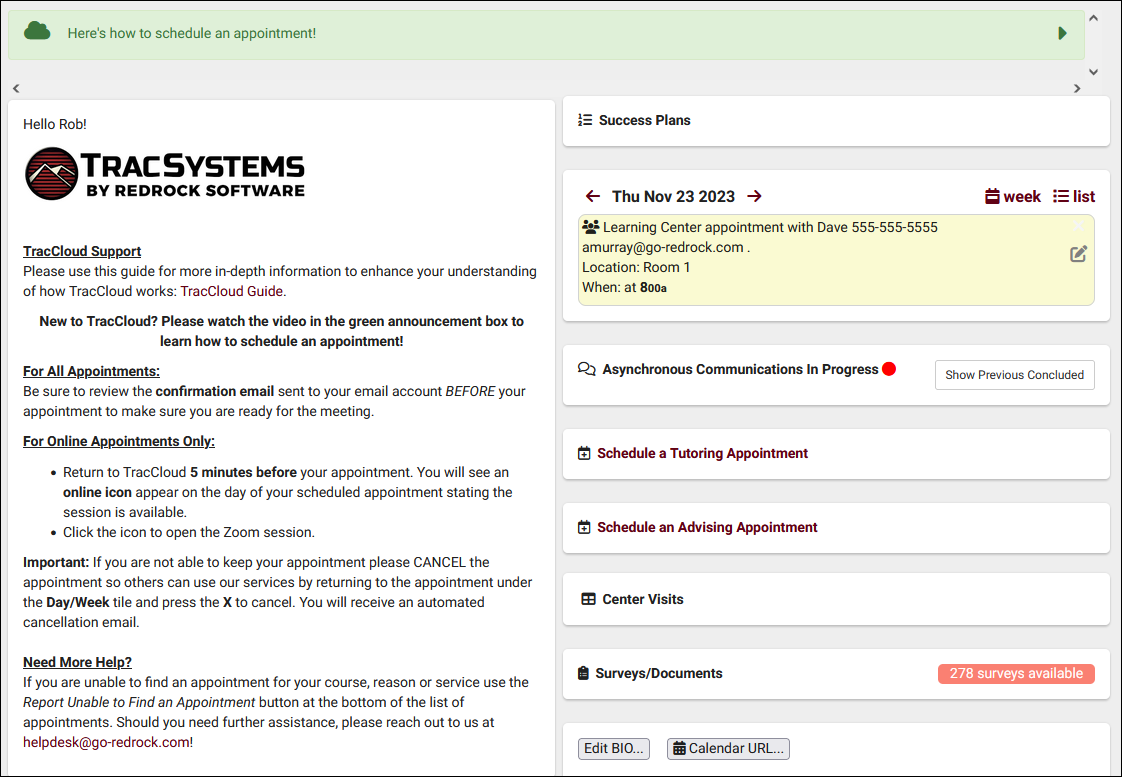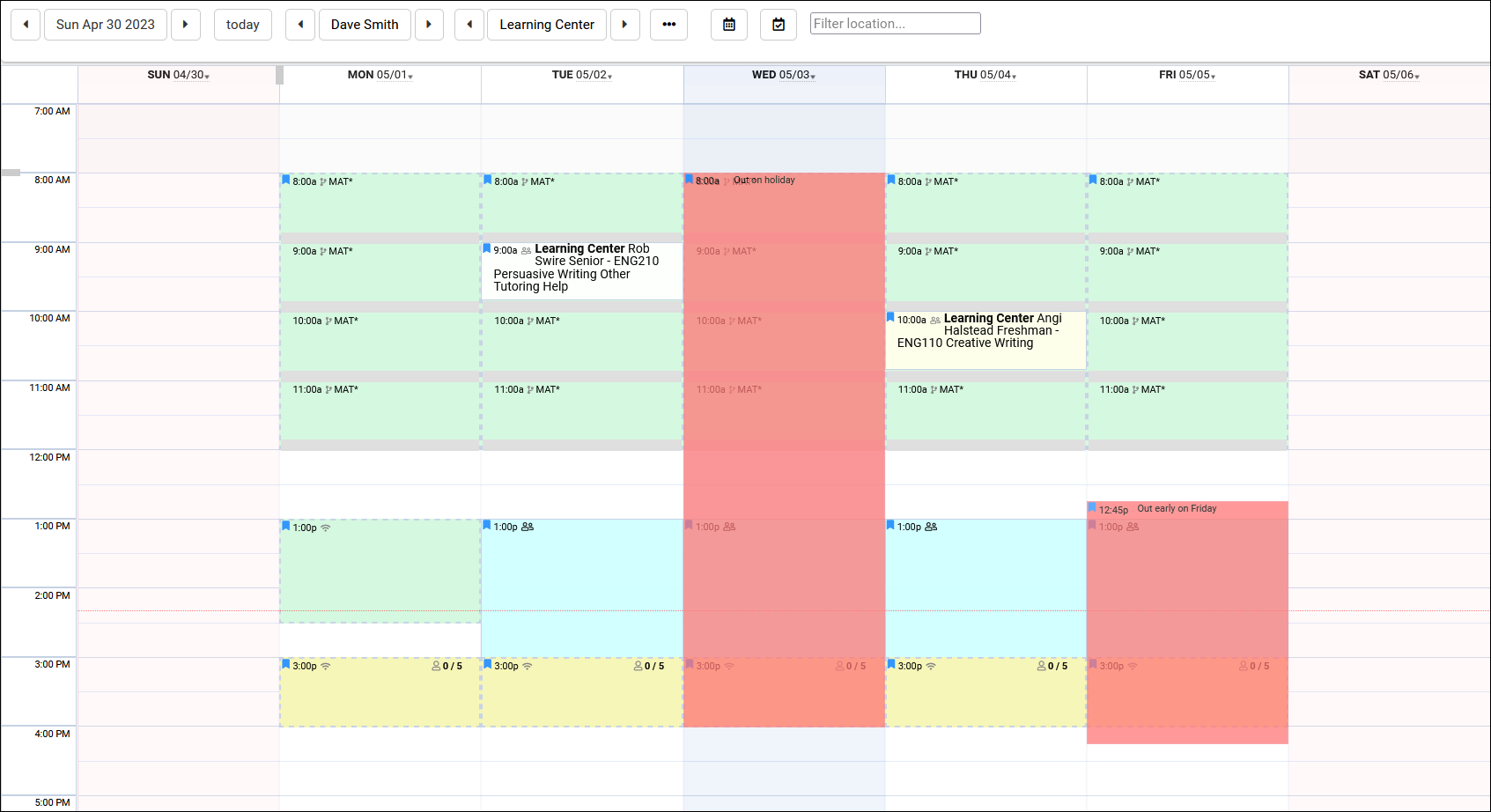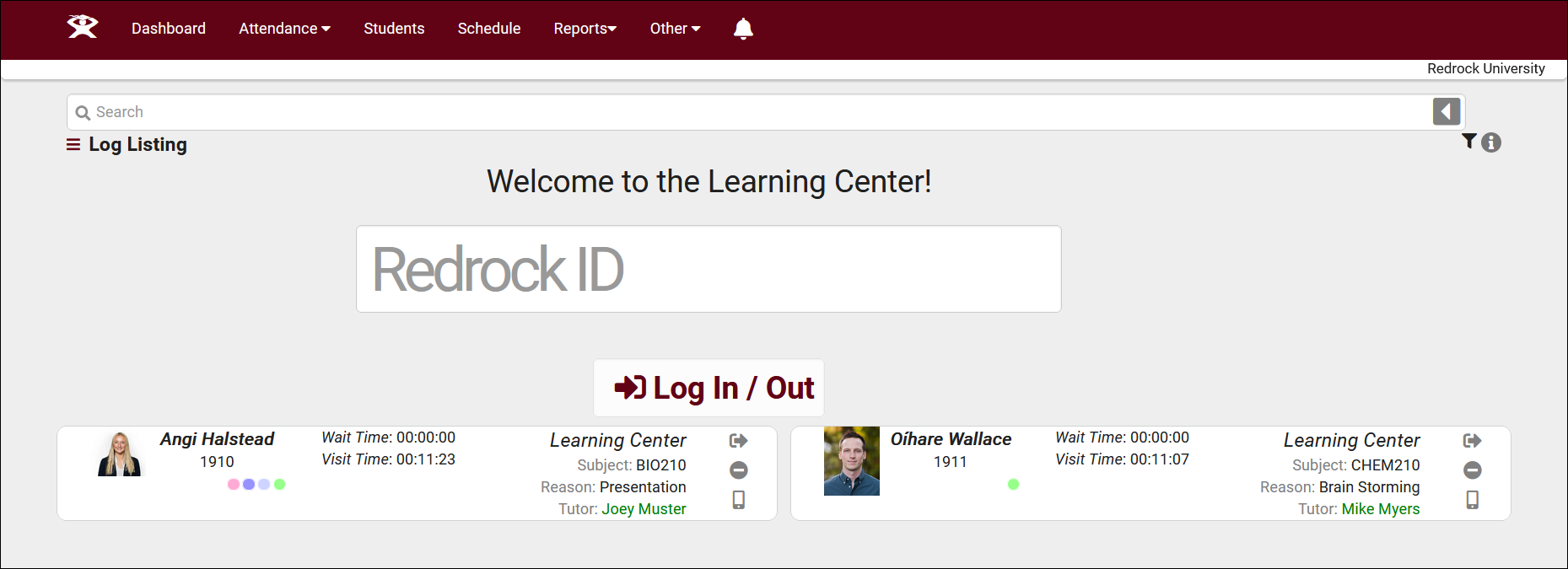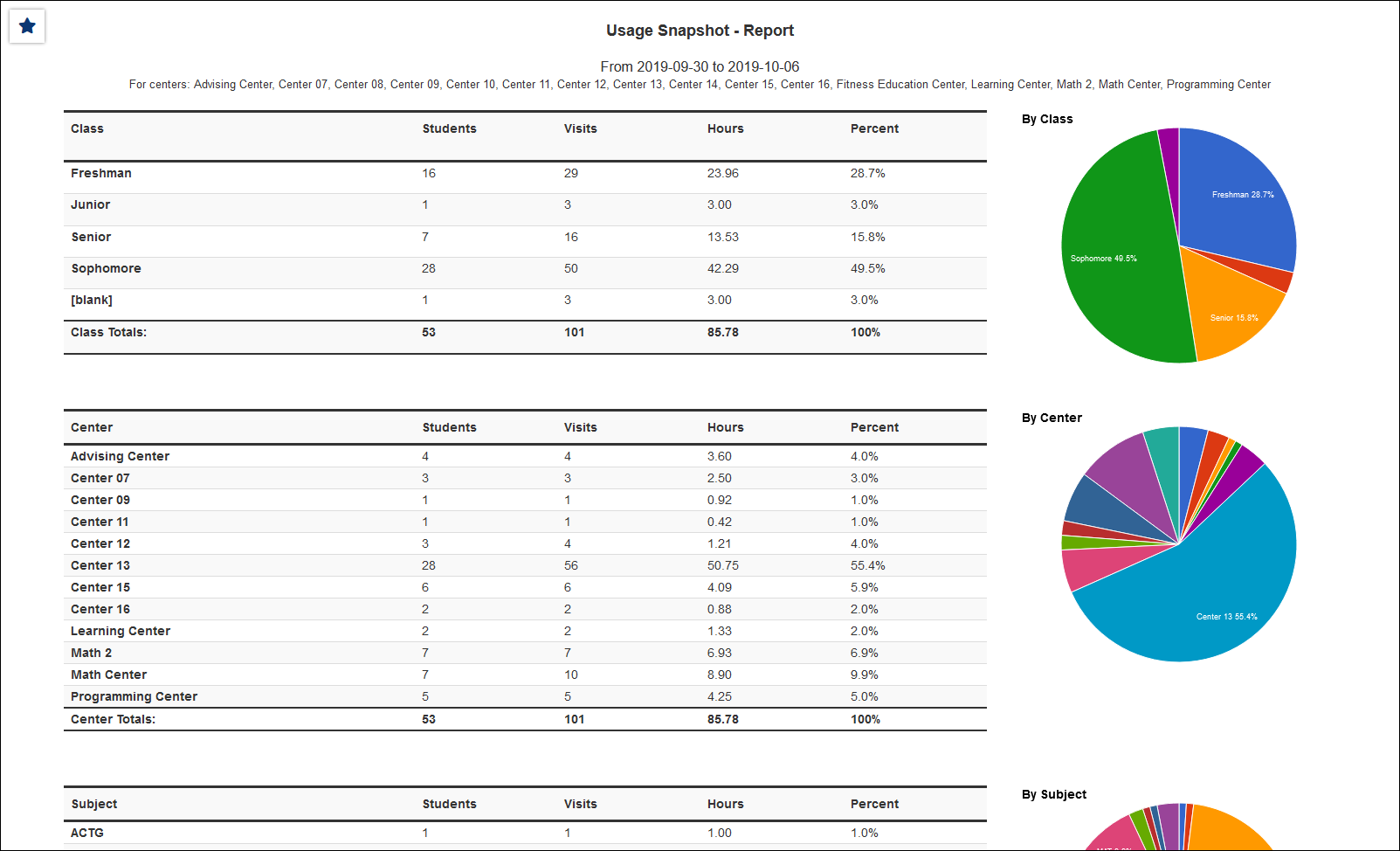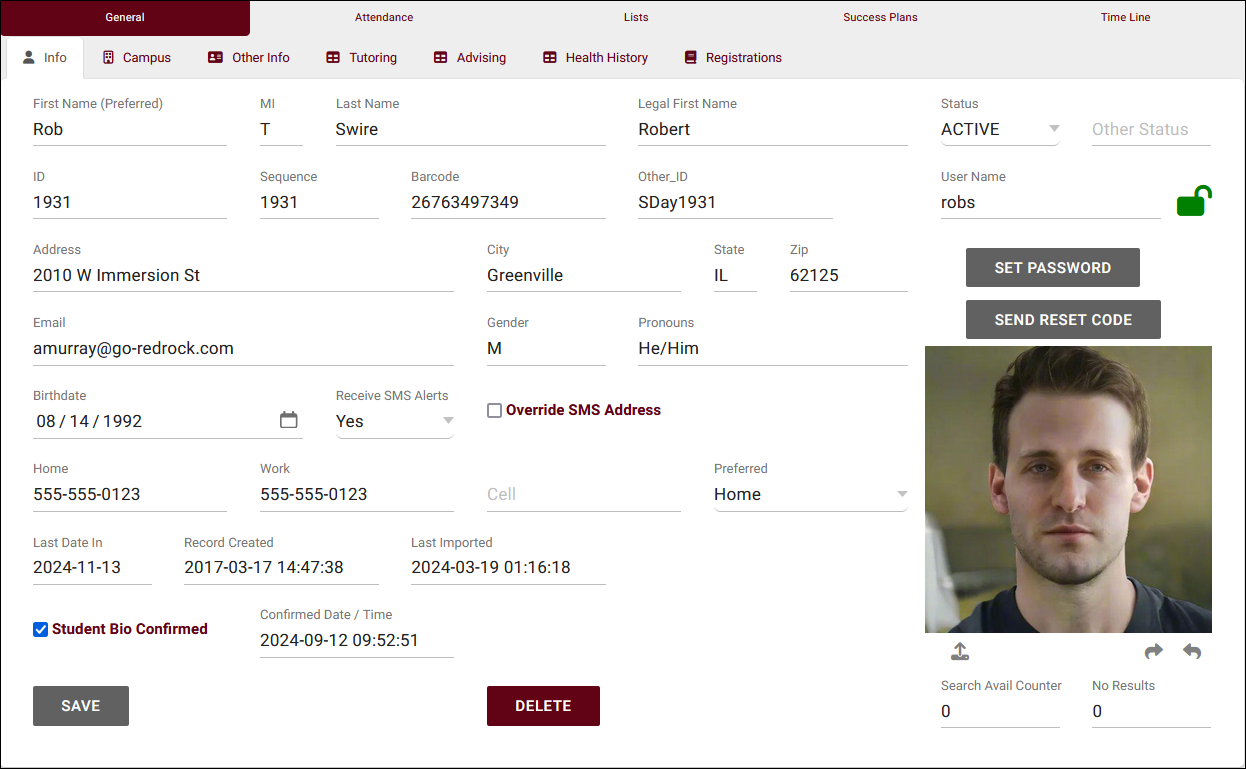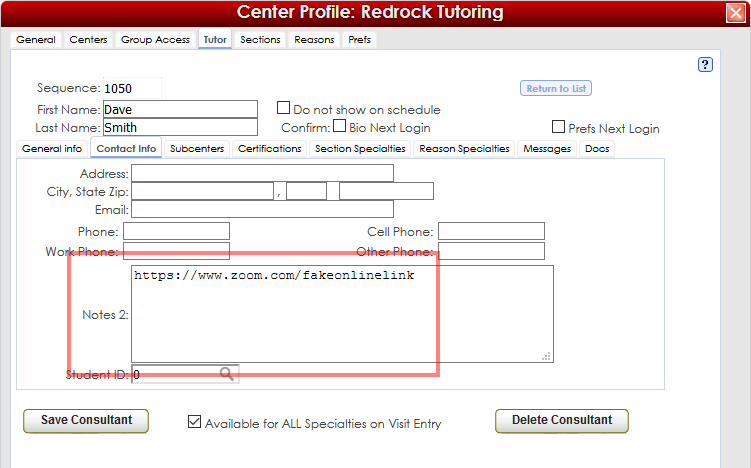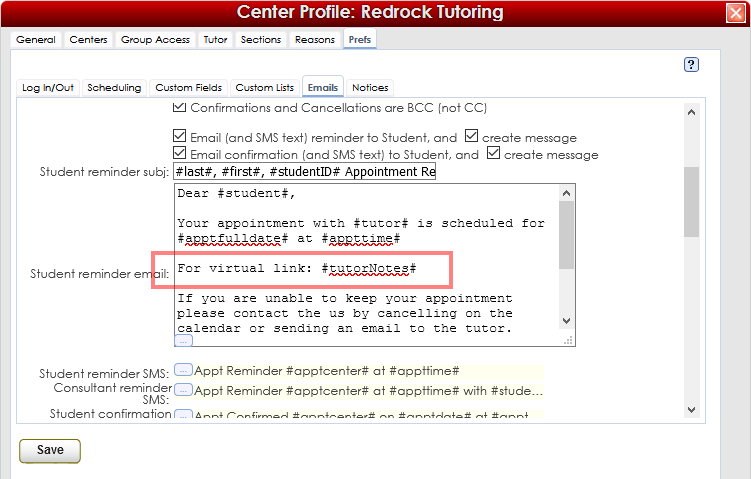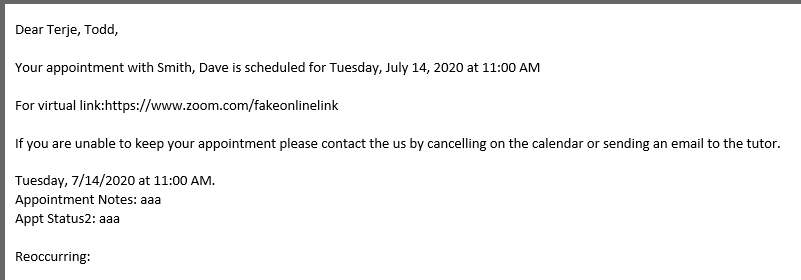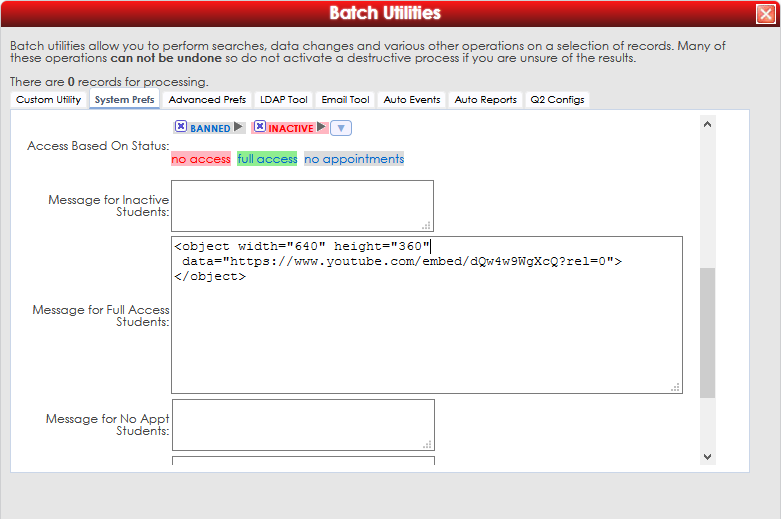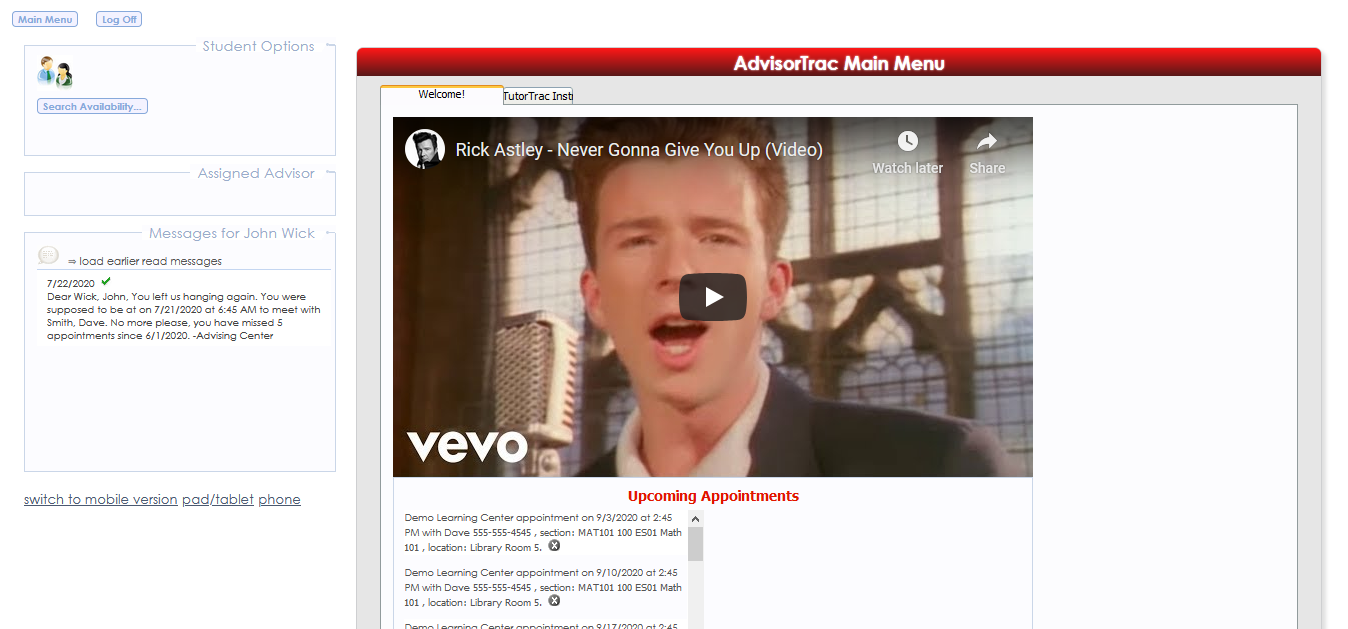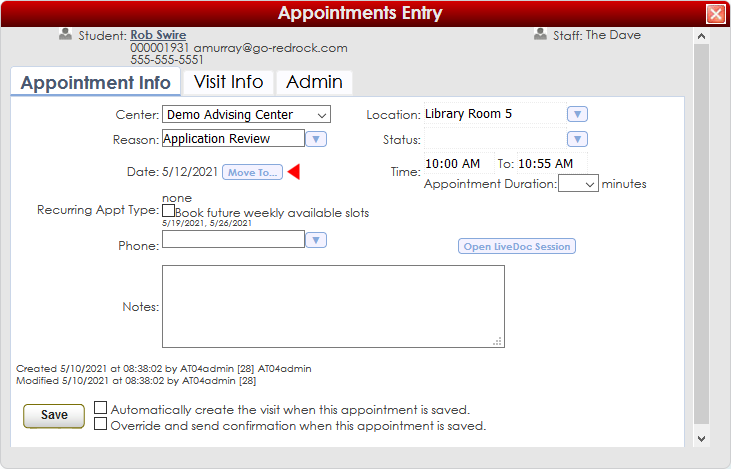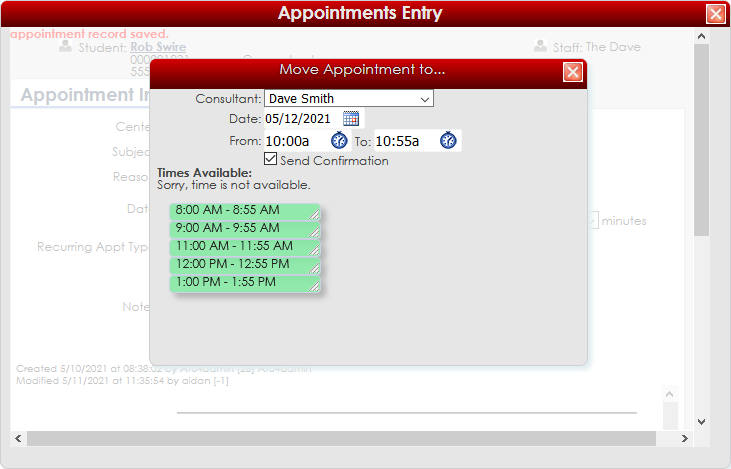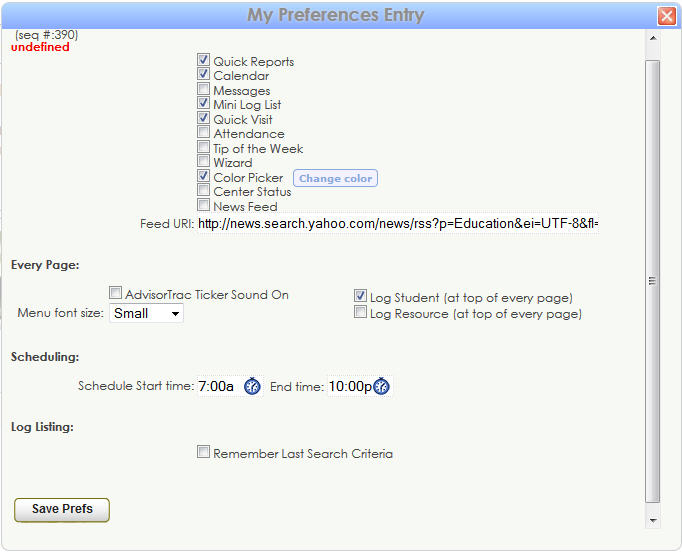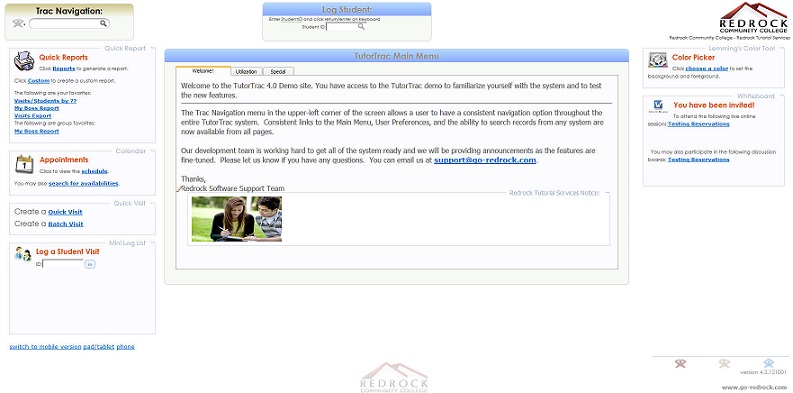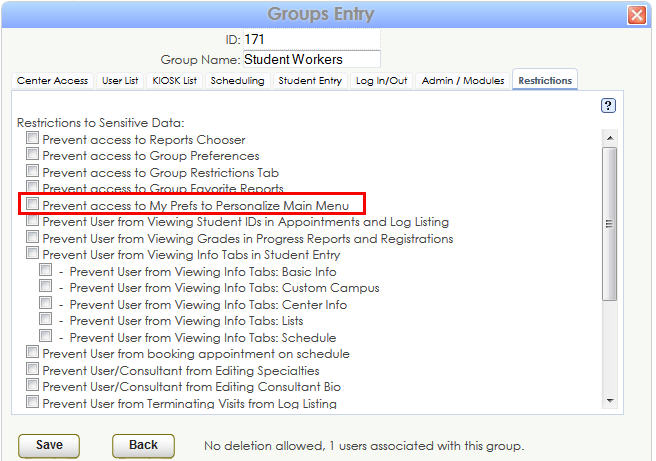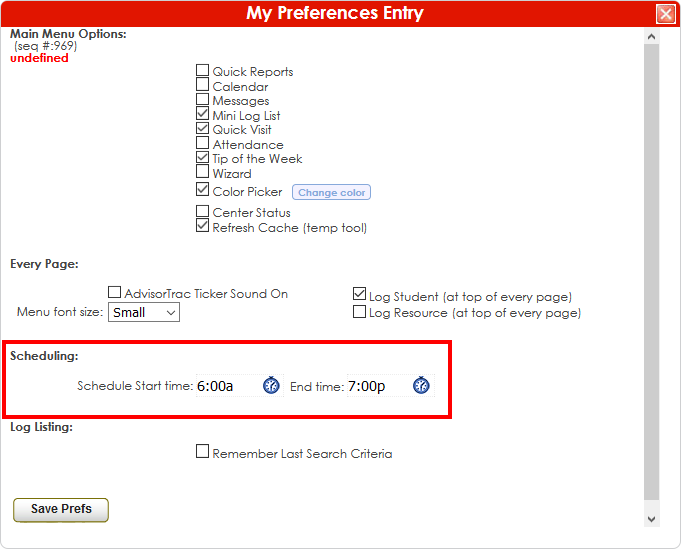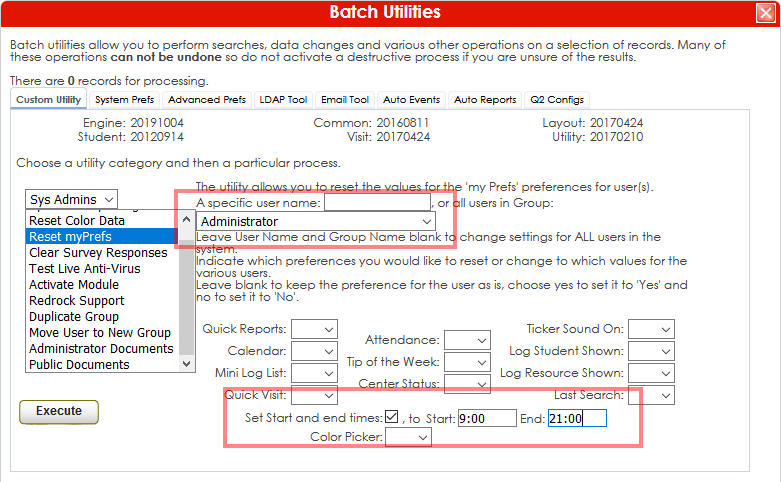FAQ
From Redrock Wiki
The legacy Trac 4.0 version of TutorTrac/AdvisorTrac/FitnessTrac is no longer receiving updates and will be end-of-life in 2025. All Trac 4.0 customers are encouraged to migrate to TracCloud. TracCloud has been designed from the ground up for speed, power, and security. Click here to schedule a TracCloud demo or reach out to sales@go-redrock.com for migration pricing or contract details. For more details about the migration process, click here.
TracCloud
For over two decades, Redrock’s TutorTrac has been a trusted solution used by thousands of centers worldwide. Now, we have completely redesigned TutorTrac using the latest, most sophisticated development tools to bring you TracCloud. Rebuilt from the ground up, TracCloud has been rigorously tested and proven effective in real-world production environments for over four years.
This transformation began with a fresh foundation — a new database (MySQL), a cutting-edge web hosting platform (AWS on Apache), and a robust development environment (PHP). But the improvements don’t stop there. TracCloud features a sleek, modern user interface designed to be exceptionally intuitive and user-friendly, making it easier than ever to navigate and manage your operations. Plus, TracCloud is fully optimized for mobile devices, allowing users to access and utilize its powerful features seamlessly from anywhere. We are now hosted on Amazon Web Services and we are taking advantage of modern cloud security, alert monitoring, and performance monitoring with automatic scalability for on-demand needs.
We are also excited to introduce new modules designed to enhance your campus’s ability to support students effectively. TracInsights for predictive analysis, Wellness Check-ins, and Reflective Prompts empower your campus to stay connected with students across your district. These tools provide instant alerts when students are struggling, allowing you to respond swiftly. Additionally, our TracFlow Automations can initiate timely interventions and connect students with the appropriate services your campus offers, ensuring no student falls through the cracks.
Guided by invaluable customer feedback, we preserved the features that made TutorTrac and AdvisorTrac so popular while embracing an ambitious vision: How can we elevate every great feature from the 4.0 version to be ten times better in the TracCloud version?
We are confident we achieved that vision. TracCloud is now a more powerful, intuitive, and versatile system while remaining affordable for every level of your institution. Whether you are a small writing center using our software for just $2,500 per year, a large multi-center support services department for under $6,000, or an extensive district with multiple campuses utilizing our comprehensive retention bundle (call for pricing), we have the ideal solution to meet your needs.
Most importantly, we are deeply grateful for the ongoing support and loyalty of our customers over the past 25 years. Your feedback and trust have been instrumental in making TracCloud what it is today. As we look to the future, we are excited to continue innovating and finding new ways to make TracCloud even more powerful and effective as a retention tool for your campus.
Training and Assistance for Your Migration
We understand that migrating from your existing, proven solution to a new platform can feel daunting. To make this transition as smooth as possible, we offer personalized one-on-one training sessions and handle the data migration for you. Our team will seamlessly convert your TutorTrac data into the TracCloud format, scheduling both training and migration to ensure minimal downtime and disruption. More importantly, we will perform the training and migration at no additional cost to you.
Unparalleled Tech Support
Redrock has built a strong reputation for responsiveness and availability. Our team remains dedicated to providing the same top-tier, unlimited support that no other company in this industry can match. Our experienced professionals are ready to assist you via support ticket, email, or phone, often responding within hours—if not minutes—of receiving your request. Over the past 25 years, our reputation for stellar support has been well-proven, and we will continue to earn our place as the leader in higher education software through our unwavering commitment to excellence.
Annual Redrock Conference
We will continue to offer in-person training and exclusive previews of the latest features and modules of our software at our annual conference. Customers have consistently reported that this experience provides a valuable opportunity to connect with Redrock team members, network with peers in their industry, share experiences, and gain insights into best practices for using the TracCloud platform effectively at their campuses.
TracCloud: Enhanced Capabilities and Continuous Innovation
TracCloud has been completely rebuilt from the ground up, retaining all existing features while significantly enhancing their performance and usability. Our comprehensive suite of capabilities includes advanced reporting, intuitive scheduling, feedback surveys, online whiteboard meetings, early alert systems, text messaging, study table management, payroll tracking, resource check-in/out, workshop tracking, task management, success plans, terms and conditions waivers, support for unlimited centers, asynchronous appointments, custom fields, custom forms, custom views, work plans, certifications, instructor attendance tracking, testing center group appointments, watch lists, student photos, batch visits, Supplemental Instruction (SI) visit tracking, email templates, and batch emails. All of these powerful features have been further improved and seamlessly integrated with new functionalities, ensuring a more streamlined user experience.
A Modern, Mobile-Friendly Interface
The enhanced TracCloud system offers a responsive, mobile-friendly interface designed for convenience and accessibility. Students can effortlessly schedule appointments by scanning a QR code and tapping a button. Similarly, they can confirm their attendance at a center by scanning a QR code and pressing a single button, providing a smoother, more enjoyable user experience. Every component of TracCloud is now accessible through this sleek, user-friendly interface, enhancing efficiency for both students and administrators.
TracCloud Reporting System is Second to None
Our reporting system capitalizes on the data we receive and generate from the operations that TracCloud manages. Because of the data capture, our reports can comprehensively indicate what resources are needed and how operations can be streamlined to maximize the help that students receive. Reports can be generated automatically by all staff, and data results may be automatically exported on a daily or weekly basis. Reports may be securely emailed on an automated schedule to the people who need the results regularly and timely. Faculty can receive automated reports on student activities, research departments can obtain raw or summarized data indicating important trends, and center administrators can gather feedback on how students are being assisted. All reports utilize the sleek, user-friendly interface that TracCloud is now known for.
Commitment to Continuous Improvement
Since the launch of TracCloud nearly four years ago, we have remained dedicated to enhancing and expanding the platform. This year, we are introducing several new modules that are easy to incorporate into your existing configuration. The Predictive Analytics module helps identify and monitor at-risk students, while the Wellness Check-In module provides valuable insight into students’ emotional well-being. Additionally, our Reflective Prompts feature encourages students to reflect on their educational journey and the steps they are taking to achieve success. All functionalities can be integrated with our TracFlow automation module, enabling timely early alerts and automated student interventions. The newly introduced AI MoodMeter field links allow proactive identification of students who may require additional support. These enhancements are just the beginning, with many more planned for release throughout the year.
TracCloud: An Enterprise Solution that still works for smaller Centers
TracCloud supports single, small centers with limited budgets while providing powerful scalability for large districts with multiple campuses. Our modular approach allows institutions to add features and functionalities as needed, seamlessly integrating them into a cohesive, robust, and user-friendly system. TracCloud continues to provide a comprehensive solution tailored to meet the evolving needs of institutions of all sizes.
A Commitment to a Holistic Approach to Student Well-Being
TutorTrac has historically been a center operations management tool. Our latest improvements with the new TracCloud have focused on the student experience and how centers truly help students succeed. Future modules of TracCloud will strengthen the connection between centers, students, and faculty, while also providing tools for Deans, Provosts, and VPs to oversee the integration of student support services from a high-level perspective. With our extensive experience in center management and student support, TracCloud is uniquely positioned to provide these essential reporting capabilities, thanks to our ability to gather data directly from the source.
Easy to Use - Easy to get Started
The TracCloud version utilizes an intuitive interface so students can quickly begin booking appointments and taking advantage of the power of TracCloud immediately. The Redrock staff will quickly train your system administrators so we can get you up and running within just a couple of weeks for smaller systems and within a month for larger implementations. Our campuses report that the training and implementation process as the smoothest experience in implementing an outside vendors software system. We aim to continue to provide this excellence in service and will continue to go above and beyond in making sure your campus is configured and setup properly and quickly.
Plug and Play with Multiple Different Centers
The TracCloud advantage is its main ability to allow multiple different centers to manage and operate the TracCloud systems in a way that works best for their own needs. The centers can optionally share their information to other centers or can keep their sensitive information private. The ability to add a new center at any time makes TracCloud a great tool that can grow with you as your needs grow. Whether you are a single, small writing center or 50 centers communicating across multiple locations, TracCloud has the same, easy to use interface.
Now, we proudly introduce TracCloud — our latest innovation in student retention and engagement, designed to streamline the management of your learning, writing, advising, or other support centers on your campus.
New, easy to use interface
TracCloud features a modern, easy to use, and mobile-friendly interface, allowing you to easily find and manage your data as you need. Students, staff, and faculty will have a much easier time navigating through the system and accessing the data they need. The new dashboard offers many easy to access widgets to view and manage your data.
New Features
Export almost any report into Excel. Static and dynamic QR codes for touchless-kiosk environments. Unlimited custom data fields in student records, visits, appointments, and more. Customizable views of listing pages. Student timelines. Twig and HTML-supported emails and system messages. Customizable log listing and kiosk views. Center descriptions. New reports. Student success plans as a new module, along with work plans for staff. The full list of changes couldn't fit in this article, and more is being added all the time. Relating to the schedule specifically, you'll find a new appointments listing, availability badges, custom search appointment links and QR codes, unlimited customizable max appointment rules, asynchronous appointment support, and more.
Customizable
With Twig support, you can personalize system messages, upcoming appointment lists, emails, and more based on the users who are viewing/receiving them. From simple changes like greeting the user by name to completely changing an email based on if the related appointment was in-person or online, in a certain center, for a certain reason, even if a certain custom field in the student's profile has a specific value. This extends to the log listing and kiosks as well, where you can add or remove fields, rearrange the data that's displayed, and add custom formatting with HTML and Twig.
Faster
Rewritten from the ground up hosted on AWS, using a MySQL database, TracCloud is faster in every way. This performance increase compared to TutorTrac or what we now call Trac 4.0 can be noticed throughout the entire system, with reports being especially improved. Even the biggest reports in TracCloud load within a few seconds.
Migrate Existing Data
Migrate your existing data from Trac 4.0, allowing you to pick up right where you left off. We'll work with you to plan out your migration, coordinating with your IT, and training your system administrators to get you started in TracCloud.
Although we now bid the old TutorTrac a fond farewell this year, we appreciate how successful it was for so many centers around the world. The new, easy to use interface of TracCloud will make our current TutorTrac users happy to move to this new version. Moreover, our support team will make the transition easy and painless!
This list of Frequently Asked Questions (FAQs) has been compiled through the emails and phone calls received by the Redrock Support Team. These questions and answers are not organized in an ordered format, but rather as a collective group of questions that you can quickly scan and search.
Technical and Installation FAQsCan the server be assigned a DHCP IP Address?No, the Trac application requires a static server IP Address. The IP Address is used to check your installation code and also to access your Trac application web interface. Can I install the Trac application on multiple computers?No, your Trac application will only be installed on a single computer. This computer will be the server (even if it is not 'server' hardware), containing the database and application in the same directory. Users can access your Trac application from any web-enabled device on the network. As a web-based application, there is no need to install the software on any other computer. Why does the Trac application quit whenever it is started?Windows Server 2003 and newer operating systems utilize a software technology called Data Execution Prevention (DEP) that performs additional checks on memory to help prevent malicious code from running on a system. The primary benefit of DEP is to help prevent code execution from data pages. Your Trac system utilizes this memory for some execution of scripts and will need to be set up as an exception in your Windows DEP settings. Can the Trac application be integrated with our campus Single Sign-on?Yes, the Trac application can integrate with your existing Single Sign-on configuration using CAS, SAML, or LDAP. This integration is customized by Redrock Software. Redrock Software would work with your campus IT Dept to fully integrate the Trac application. How can our Trac website be secured?Redrock Software recommends utilizing a 3rd party application named Stunnel to encrypt the data between the web server and the users' web browsers. Stunnel is a free, open-source SSL wrapper that is installed on the server with the Trac application. The Trac application connects with Stunnel without encryption on the local server. Then, Stunnel encrypts the data and connects with the users' browsers across the network. Can we run our Trac site from an IIS or Apache web server?No, the Trac application utilizes a custom web server developed by Redrock Software. The web server was developed to integrate fully with the built-in 4th Dimension database. Click "Expand" for more information. Internet Information Services (IIS)
To change the server port, open the file Prefs.INI that is located in the Trac application directory. You can use WordPad or Notepad to edit the Prefs.INI file. Locate ServerPort=80. Change 80 to 81 to serve the Trac application on port 81. Restart the Trac application and it will now be serving its web pages on port 81 (or another specified port). Can our Student Information System integrate with our Trac application?The Trac application can import data from any source as long as it is provided in the correct format. The data needs to be provided in a flat file format. .TXT, .CSV, .DAT, .LIS, and .XML are examples of valid file formats. The Trac application will not import data from Excel files. The data must be saved in a flat format. The order and delimiter of the fields is completely up to your preference, however, the format, order, and delimiter of the fields must remain consistent with every import. Redrock Software recommends that the student demographic data be imported with the students' course registrations and course instructors. Can the Trac application run as a service on the server?Yes, the Trac application can be run as a service so a user is not required to remain logged on to the server for the Trac application to run. The Trac application is installed as a service by utilizing a small application named Winserv. See the article, Install the Trac Application as a Service, for more detail to install the service with the Winserv utility. What are the steps to allow students to book an appointment online?The Trac System allows students to book appointments online and join online sessions via any conferencing software that supports static URLs. More information on what's required to configure these features can be found by clicking "Expand." What are the steps to allow students to book an appointment online? IT
Trac Administrators
User FAQsCan the remote tutoring link be included in the confirmation email?Due to how the Trac System keeps track of remote tutoring visits, this is not possible without limitations. When the "Join Online Session" link is clicked by the student, the Trac System creates a visit record and marks their appointment as attended. If the link is sent in an email, it would not be possible for the Trac System to know when the link is clicked. However, there is a workaround available if this is absolutely necessary. Click "Expand" for more information. How do I add consultants' online links to the confirmation/reminder email? Due to how the Trac System keeps track of remote tutoring visits, this is not possible without limitations. When the "Join Online Session" link is clicked by the student, the Trac System creates a visit record and marks their appointment as attended. If the link is sent in an email, it would not be possible for the Trac System to know when the link is clicked. We do have a workaround available for including these links in the confirmation email, but the downside is that consultants/admins will need to either log the student in/out for the visit, or create a quick visit after the fact. If you're okay with this limitation, simply follow the instructions below: These options can be found by going to Trac Navigation > Search Glass > Center Profiles > [Your Profile]
Here's what our example email would look like: What is a Profile?A Center Profile allows you to set up users, consultants, groups, and centers that share preferences and settings. The Groups will establish group privileges and settings for users and consultants. While the individual centers share the global profile settings, the groups and users can be restricted to accessing information by to each center. Why would I need another Profile?Another Profile would be needed when multiple centers cannot agree on the settings within the same Profile. There are three key areas of settings in which centers might have a conflict: Log In/Out, Appointment Scheduling, and Email Settings. Can I add a Profile to my existing Trac system?Yes, a Profile may be added to an existing system at any time. A Profile has an additional cost. You will need to contact Redrock for assistance in purchasing and activating a new profile at Sales@Go-Redrock.com. How do I set up multiple centers?A Centers tab appears at the top of your Profile Entry screen. This tab gives access to the unique Centers that are set up for the Profile. A Center in the Trac application is a unit that has unique Consultants, Schedules, Visits, and Reports. The Centers will most often be setup according to unique departments, however, you may set up your Centers according to any convention that fits your needs. How do I ask a custom question on appointment entry?You can create a custom appointment question by going to Trac Navigation > Search Glass > Center Profiles > [Your Profile] > Prefs > Scheduling > Custom Appointment Field. More information can be found in the hyperlink above. What is a Sequence Number/ID and why is it important?Sequence IDs are numbers that are assigned to a variety of different elements within the Trac Software. These numbers are automatically assigned and remain static so that when other information that is associated with the element (i.e. name, spelling, etc.) changes, there is no confusion as to which records are associated with each other. One example would be if a Subcenter named: “The Writing Center” were to change their name to “The Reading and Writing Center” the Sequence ID would remain the same thus allowing previous visit data to remain attached to it. How do I set our school logo?The Trac system provides a place for a logo image to appear as a banner in the upper-right corner of your Trac system web pages. The banner is a .GIF image file named SchoolBanner.gif and is placed on the Trac server in the /Webfolder/TracWeb40/ folder of your Trac application installation directory. Redrock Software recommends an image height no greater than 75 pixels for your banner. Consider the users' screen resolutions when considering the width of the banner image. Instructions for uploading an new logo can be found in the hyperlink above. How do I change the Trac colors?A Trac System Administrator can set up the default colors of the titles and title bars on the Trac system windows. The Trac System Administrator can set these colors from the System Preferences found in the Utilities & Prefs. The campusColorData preference provides a setup utility to select and test colors before implementing the colors for your Trac System. How do I embed a Youtube video on the Trac System?It's possible to embed a Youtube video in almost any HTML supported text box in the Trac System with the <object> tag. Click "Expand" to view more information.
https://www.youtube.com/watch?v=dQw4w9WgXcQ
https://www.youtube.com/embed/dQw4w9WgXcQ?rel=0
<object width="640" height="360" data="https://www.youtube.com/embed/dQw4w9WgXcQ?rel=0"> </object>
How do I change the login instructions?Any user that logs into your Trac system will log in through the same screen, so the login instructions are global to your Trac system. The instructions are found in the System Prefs. The name of the pref is MsgsAll. The instructions can be formatted with HTML to customize your fonts, colors, and sizes or add links and images. How do I set up a nice URL or website to access the Trac system?Your Trac application serves the Trac system web pages from the IP Address of the server. Your Trac system will be accessible via web browser by entering the IP Address as the URL. You can set up a domain name for that IP Address through your network administrator. When your site has a domain name, you will be able to access your Trac system by a recognizable address like https://Trac.College.EDU. How do I load student and course data to my Trac system?Your Trac system can import student and course information via ASCII flat text files (usually students.txt and courses.txt). You must obtain these files from your student information system. Provide a sample of the file to Redrock Support, and you will receive a script that imports the data from the flat file to your Trac system database. So long as your file format remains the same, you will be able to continue to import updated student data to your Trac System. The entire process can be automated so you don't even need to do anything. How do I activate courses for a new term/semester?Activating new courses is a multistage process. Once the new courses are imported, you must adjust the term code within your System Prefs, activate the courses for each Subcenter, and transfer the Section Specialties for your consultants. Click on the Link for detailed instructions. If you have recently set up an account and notice that your screen looks incredibly bare, you’ll need to save your personal preferences within the MyPrefs settings. Click on the Trac-Man Icon, scroll down and select My Prefs. You will notice that many preferences are already checked, but they do not take effect until the ‘Save Prefs’ button is clicked. Make any adjustments that you’d like and click ‘Save Prefs’. Once you click ‘Save Prefs’, go back to the Main Menu and refresh the screen to see the utilities. How do I change my Sys Admin password?To change your Sys Admin password, go to Trac Navigation > Search Glass > SysAdmin Group > User List > [Your User]. Here, you can change and confirm your password, then click save to apply changes. Click "Expand" for more information. To change the system administrator password click on the search glass from the main menu and click SysAdmin Group. 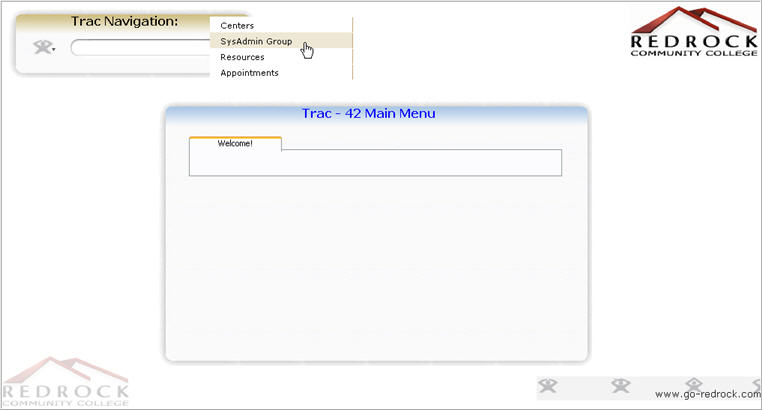
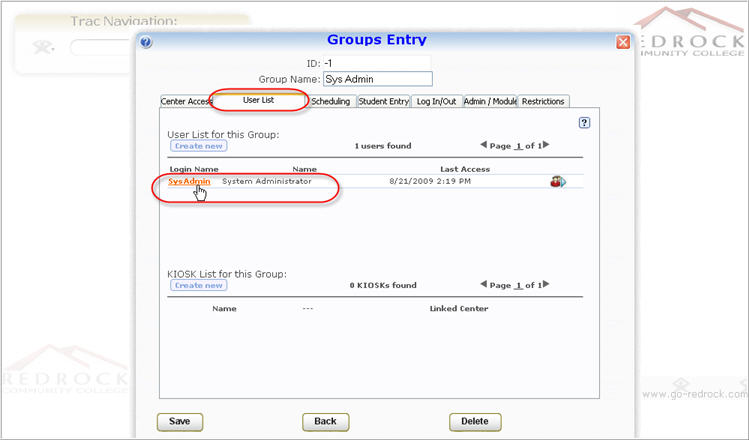
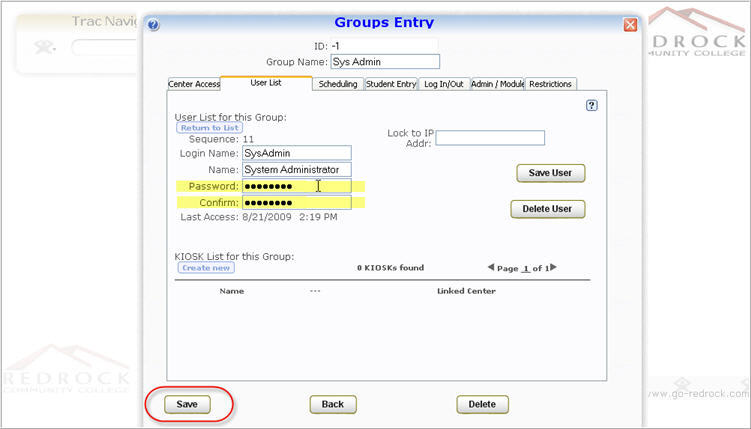 How do I notify instructors when their students are visiting?The Trac System has a couple of standard functions in place to allow you to contact the faculty when their students visit your center(s) for assistance. You can ask the students to check a box to email their instructor as they sign out of a visit. You can ask the consultants to enter their session notes and then click a button to email the visit information and notes to the instructor. You can even automate a process to run nightly or weekly and email the faculty a list of all of their students that have visited. Redrock Support will assist you in setting up these options. How do I set up emails from my Trac system?The Trac system has a global setting to store a value for an SMTP Mail Server. The setting is found in the System Preferences. The preference name is MAILSERVER. It can be entered with a domain name or an IP Address. The mail server needs to allow anonymous mail relay from the Trac server IP Address. An incorrectly entered mail server can cause your Trac system to operate very slowly as it attempts to connect to a non-existent mail server when scheduling or cancelling appointments. How do I send an email to a group of students?The Trac Navigation allows you to search students very quickly. When you have searched and found a selection of students, you can choose to send an email to this entire group at once. You can do so by choosing to Send HTML Note from the List Options menu. Enter your email subject and message and then choose if it is an email or just a note within your Trac system. Click Send Message to complete the message and send it to the group of students. How do I email students a reminder of their appointments?Each Center Profile has its own unique preferences and settings. The Email tab in the Center Profile Prefs allows you to set up and format email reminders for appointments. Reminders may be sent to students, consultants, or both. The reminder message is formatted differently for the students and consultants. A student can receive a reminder for each appointment that they have scheduled the next day. A consultant can receive one email that details all of their scheduled appointments for the next day. Additionally, the Trac system has a global setting that controls when email reminders are sent. The Automated Events tab in the Utilities and Prefs contains the timing settings and activation of the Email Reminders. How do I email consultants a reminder of their appointments?Each Center Profile has its own unique preferences and settings. The Email tab in the Center Profile Prefs allows you to set up and format email reminders for appointments. Reminders may be sent to students, consultants, or both. The reminder message is formatted differently for the students and consultants. A student can receive a reminder for each appointment that they have scheduled the next day. A consultant can receive one email that details all of their scheduled appointments for the next day. Additionally, the Trac system has a global setting that controls when email reminders are sent. The Automated Events tab in the Utilities and Prefs contains the timing settings and activation of the Email Reminders. How do I receive a copy of the emails that are sent to students?Each Center Profile has its own unique preferences and settings. The Email tab in the Center Profile Prefs allows you to configure email settings. You can configure a Center email address that will be used to send email confirmations and reminders to the students. There are checkbox settings to allow this same email address receive a copy of the appointment confirmations, reminders, and cancellations. Can I watch/follow lists that I have created within the Trac Application?Yes. It is possible to watch/track lists with the Watch List Indicator. The Watch List Indicator allows you to assign a colored dot to the list of your choosing which shows up next to the name of the students on your list. You can set who can see the indicator as well as where it shows up. When the indicator is hovered over, it will give you a the name of the list associated with it. Students can be members of multiple lists and the Watchlist indicator can follow up to 9 different groups. What is the difference between an availability, an appointment, and a visit?An availability is an designated time that a consultant offers for student appointments or drop-in visits. An appointment records that a student reserved a time to meet with a consultant. Appointments may be assigned a status to identify the outcome of the reserved time. A visit records that a student utilized the services offered at your center(s). Visits may be logged in real time by asking the student to sign in when they arrive and sign out when they leave or they may be recorded after the fact. Can I book my appointments in Outlook? Does the Trac system integrate with Outlook?When an appointment is scheduled the Trac application can send a confirmation email. Included in the email is an iCal attachment. This attachment will display appointments in your Outlook calendar as meeting invitations. iCal Integration with your Trac system - Why is this a one-way relationship? The integration is one-way, but it's important that a user understand that two-way integration is not really feasible. AdvisorTrac, for example, allows for appointments to be scheduled between an advisor and a student. These appointments can be scheduled by the student, advisor, front desk staff, student workers, administrators, or any number of other users in the system. That means that correct levels of access to the schedule needs to be provided to the proper users. There are also many other factors that affect the scheduling, including rules for scheduling appointments, individual or group appointments, reasons for appointments, and so on. The AdvisorTrac system has a record of the advisor and a record of the student and will use scheduling rules and permissions for users to schedule the appointments. When an appointment is booked in the AdvisorTrac system, the basic information of the appointment (date, time, duration, student, advisor, reason, etc.) is passed in an iCal attachment to the user's Outlook calendar. Outlook does not enforce rules or include permissions for many users to search and interact with advisor schedules to book appointments. When an appointment is booked, Outlook has no idea of who the student is or who the advisor is or if there is a rule that should have prevented the appointment. Outlook cannot communicate all of the necessary information, provide the level of access, or follow a basic set of scheduling rules as AdvisorTrac can, so the two systems may not speak directly one with another. Can I block times from my schedule?Yes. Blocking times can be done in two ways. First an individual consultant can create an availability block by creating an availability and then unchecking the "is availability" checkbox in the top right corner of the availability creation window prior to saving. The second method is creating a block for an entire center which can only be done by administrators in the Center Profile> Centers tab. How do I block times that my school/center is closed?To create a center block you must have admin privileges to the Center Profile. In the Center Profile you will go to the Centers tab and click on the ID number of the center you would like to create the block for. Click on the "new" button in the center of the page and enter the details of the block. Note: if you would like to create a block for all center you will need to choose the Center Profile and check the box "is Global to all Subcenters?" located above the description field. How do I move an appointment from one consultant to another?Moving an appointment can be done by identifying the appointment you would like to move and accessing the "Move to" feature. This will allow you to the move the appointment to another consultant, day, or time. Click "Expand" for more information. Moving appointments from one time to another can be done on the schedule by clicking and dragging. You may also use the Move To button from within the appointment entry screen to move the appointment. Moving Appointments Overview Moving by clicking the Move To button has a lot of flexibility and more wide-reaching effects, therefore a special privilege for moving the appointment is given by clicking on the checkboxes located in the scheduling tab of the Group preferences. Practical Uses for Moving by Clicking the Move To button The button is available in the appointment entry for existing appointments only. This button only appears in the appointment entry if the user's group has the Move To option checked and the appointment is an existing appointment. Setting up the Preferences
Be sure to click Save after making the desired choices.
Open an existing appointment and locate the Move To button to the right of the appointment's date. Click the button to display the Move To dialog. This is a way to move appointments from one consultant / date / time to another. Changing dates, times or consultants causes the system to display the new availabilities. The change button will appear if the chosen options do not conflict with an existing appointment.
After doing so the Change button will appear. Click the change button to record the changes and the appointment will disappear and the schedule will reappear. Can I delete or change a large group of visits all at once?Yes, this can be accomplished with the Change Value utility. However, due to the potential destructive result of this kind of batch change, we recommend that you reach out to Redrock Software directly for assistance. How do I survey a group of students?Surveying a group of students is simple if you have SurveyTrac. SurveyTrac affords you the ability to create an unlimited number of surveys with an unlimited number of questions that can be given on student entry, exit, or sent out within an email. Students can be emailed surveys individually or you can pull up a specific group of students and email the survey all at once. For more information on SurveyTrac, contact us to set up a demo. Why isn’t a consultant showing up on the schedule?In order for a consultant to show up on the schedule, there are two settings that must be in place. First, the consultant must be assigned to the Center Profile in which the Center resides and second, within the Consultant Profile under the Subcenters tab make sure to select the Subcenter that should have the Consultant on the schedule. Consultants can reside on multiple schedules and within multiple Center Profiles if you choose. Why can't a consultant/user view the schedule?There are a couple of permissions and settings that need to be in place to enable a consultant/user to see the schedule. These permissions can be found in the Center Profiles under the user group settings. How can staff/consultants change/reset their home screen?Your Staff can modify the visible elements of their home screen by going to Trac Navigation > Trac-Man > My Prefs. View more info by clicking "Expand." The My Prefs involves the personal preferences that users can choose to customize the Trac system for themselves such as including adding some Widgets to the Main Menu, such as a Mini Log Listing, Reports, custom window colors, Weekly Tip, and a custom RSS news feed. The user's ability to enable some of these preferences is dependent upon the access provided them through their assigned Group.
How to set your My Prefs
How to restrict access to My Prefs The user's assigned Group can be restricted from editing their own My Prefs. In the Trac Navigation go to the Search Glass then Center Profiles and click on your profile. From the Center Profile go to the Group Access Tab and select the Group you will need to remove the My Prefs option from. Finally go to the Restrictions Tab and deselect the box Prevent access to My Prefs to Personalize Main Menu and then click cave.
Should I delete past consultants that are no longer working with us?No. There is no safe way to delete a consultant. What we recommend is marking the consultants that you wish to remove as ‘Inactive’. This will allow previous records to remain attached to that consultant and make for the most accurate reporting possible. To ‘Deactivate’ a consultant, simply navigate to the Consultants (tutors, advisors, counselors, etc.) tab within your Center Profiles and uncheck the box next to their name. Should I delete Subcenters that we no longer use?No. There is no safe way to delete a Subcenter. We recommend marking the Subcenters that you wish to remove as ‘Inactive’. This will allow previous records to remain attached to that Subcenter and make for the most accurate reporting possible. To ‘Deactivate’ a Subcenter, simply navigate to the ‘Centers’ tab within your Center Profiles and uncheck the box in the middle of the frame under the term ‘Active’. How do I change the time range on my schedule?To change the schedule time range for yourself: Go to Trac Navigation > Trac Man icon > My Prefs. Change "Schedule Start time: __ End time: __" to your desired times, then save. For more information, and to change the time range for everyone, click "Expand." To change the schedule time range for yourself Go to Trac Navigation > Trac Man icon > My Prefs. Change "Schedule Start time: __ End time: __" to your desired times, then save.
Go to Trac Navigation > Trac Man icon > Utilities and Prefs > Custom Utility > Sys Admins category > Reset myPrefs.
You'll want to change the '...or all users in Group' setting to your users' group (or leave blank for everyone). Then at the bottom of the screen, check 'Set Start and end times', and input the time range you'd like their schedules to use. This uses military time, so for example, you'll want to use '9:00' to '21:00' for 9:00am to 9:00pm. Click "Execute" to save. Reporting FAQsCan reports be run automatically?Yes, reports can be run automatically with our automated reports feature. Reports can be run in a variety of increments and can be delivered via email to an individual or a group. How do I run a Supplemental Instruction (SI) Report?Running an SI Report is an extremely efficient way to identify the usefulness of your SI Program. Running the report is simple. Click "Expand" for instructions. Follow the steps below to run an SI Report at the end of the semester: Be sure that grades have been reported by faculty and imported from your Student Information System. 1. Log in as a user/consultant that has appropriate access to the Registrations reports and Subcenter information needed to execute the SI Report. 2. Click on the TracMan Icon in the upper left and select ‘Reports’. 3. From the dropdown menu select the ‘Registrations’ category. 4. From the new list of reports choose the ‘SI Comparison’ report. 5. After the options load, choose a center to report on. 6. Select the ‘Visit Search’ link and enter the specific Section within the ‘Section’ field. 7. Select the ‘Registrations Search’ link and enter the specific Section within the ‘Course ID’ field. (note: the Visit Search and Registrations Search sections must match exactly). 8. Choose your date range (i.e. this semester). 9. For the ‘SI Group is:’ option, select ‘Visited’. 10. Adjust the passing and non-passing grades to meet your standards. (note, these must be in the correct format or they will generate an inaccurate report. Do not place any spaces after commas or between grades). (Good Example: a,a+,a-,b,b+,b-) (Poor Example: a, a+, a - , b , b +, b) 11. Adjust the ‘Affects of SI on Visits Breakdown’ to your preference. Once again, pay close attention in following the proper formatting. 12. Complete filling in the settings to meet your preferences and select ‘Generate’ What are the differences between the “Students/Visits by??”, “Visits/Students by??”, and “Appointments/Students by??” reports?The primary difference is what the report is using as its logic to run the report. The “Students/Visits by??” report will provide the total number of students and visits grouped in a variety of ways; the “Visits/Students by??” report provides visit data through a variety of fields; while the “Appointments/Students by??” displays appointment data for your subcenter(s). The Appointments/Students by ?? report displays Appointment data for your subcenter(s). Information can be organized and sorted via the “Group Appointment By” and “Group 2” fields. For each group selected, the dates and times are listed as well as Appointment status (attended, cancelled, missed), student, and subject. The report can be regenerated for a specific center, an individual student, group of students, an individual Consultant, or for different date and time ranges. Additional fields can be added with regards to Student, Appointment, and Visit Information. The Students/Visits by Report will provide a total number of students and visits, grouped by the chosen field on the left. Each field is listed with its associated students, individual student data, number of visits by the student, and total hours of each visit. The Visits/Students by Report provides visit data through a variety of fields. Data can be grouped by two fields of your choice through the Group Visits By and Group 2 fields. Additional Fields can include student ID, name, date, times, subject, reason, and visit notes. Total visits and hours are listed beneath each section. |
